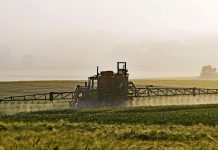(Scroll down to see more photos from this event.)
WINONA, Ohio — You knew you weren’t on a typical livestock farm pasture walk when the host said of his pastured animals, “They are still fairly wild. If we keep quiet as a group, and stick together, I think we’ll be OK.”
And that might be what drew a crowd of 80+ July 28 to the Eastern Ohio Grazing Council event at Heritage Lane Farm, owned by Kevin and Sarah Swope, in Columbiana County.
The Swopes raise buffalo on their 53-acre farm near Winona, Ohio. The pasture walk featured their divided paddock management system, used to raise and feed out the shaggy giants.
Swope is also the district conservationist for the USDA’s Natural Resources Conservation Service in Carroll County.
Great grazers
Swope, who has been raising buffalo since 1997, said the beasts are the “epitome of quality grazers.”
“They are perfectly designed to fit the grazing season,” he explained, particularly since they calve in later spring, typically April, and require only 1.6 percent of their body weight in dry matter during the winter, compared to 2.5 percent the rest of the year.
That means when forage supplies are limited in the winter, the bison are eating less anyway.
“I like that a lot,” Swope added.
Pasture management
He moves the buffalo in two groups of 20 and 25 head each: the cows and their calves, and the yearlings. A bull is in with the cows all the time.
His 40 acres of pasture is divided into 12 contiguous paddocks that range in size from 1.5 to 4.5 acres. Depending on the season, forage growth and the paddock size, he can graze each two to three days.
This year, he added an electrified Gallagher wheel fencing system to split the paddocks into smaller sections to control grazing even further and move the bison through the pasture.
“We’re trying to only feed what they’re going to consume,” he explained.
With the wheel fencing, he can move the bison forward as needed, with a back fence about two days growth behind them. “They like to run a lot,” Swope said.
He estimates he could possibly double the grazing life of a paddock with the system.
“We just keep further dividing and further dividing.”
The buffalo will respect a single strand of poly wire for internal fencing, Swope said, “if they’re content.”
For the year-round grazing system, they stockpile forage in the paddocks, and they make 100-120 large round bales of hay to get them through the winter, and unroll the hay bales out in the pasture.
Water is provided by a spring by the house, through a pressurized system of buried pipelines and overland pipe to three frost-free hydrants, a series of moveable tanks and one winter flow-through tank. A shallow well jet pump is located in a heated wood shop.
This is the first season for the overland lines, but so far Swope likes the system. The 3/4-inch water lines run along fence lines, and he uses a quick connect valve to channel water into portable stock tanks.
It takes between 26 and 30 months to feed the bison to a market weight of around 1,000 pounds.
The Swopes retail meat cuts, processed by Whitefeather Meats in Creston, from their farm and at farmers markets, and Whitefeather also buys buffalo meat from them to retail.
Warm season grasses
The Swopes had to completely convert the acreage from crop production to the forage system, and have been continually working to diversify the grasses, including introducing more warm season grasses like switchgrass and big bluestem that are native to Ohio.
Bob Hendershot, state grazing specialist with the Natural Resources Conservation District, was also present at the pasture walk and encouraged more farmers to consider the warm season grasses for at least 10 percent of their farm. Those species are harder to get established, he said, but have a deeper root system once they do, and get up to 7 feet tall if not clipped or grazed.
Hendershot said varieties that have a hollow stem will have one-tenth the hay loss in a large round bale of cooler season grasses, and animals will find the stem as palatable as the leaves.
He also said farmers could see as high as 4 to 5 tons of dry matter yield of warm season grasses per acre, compared to Ohio’s average hay yield of 2.2 tons per acre.
Farmer to farmer
“I’m in a constant state of learning,” Swope said, and gave a shout-out to longtime Carroll County cattle grazier Earl McKarns in the crowd. “I got a lot of direct inspiration from Earl.”
And that’s what the Eastern Ohio Grazing Council is hoping will happen from events like this pasture walk: More talking and more questions and more learning, farmer to farmer.









